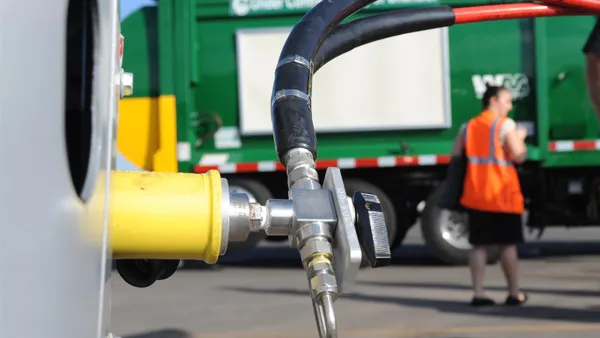Dive Brief:
- Covanta reported a slight increase in Q1 revenue compared to the same period last year, with a 1.7% increase in processing revenue and a 2.5% decrease in energy revenue mainly due to facility downtime and unfavorable power markets. The average overall revenue per ton for waste was up by about 3% due to a variety of factors, including continuous growth in Covanta's profiled waste business.
- During the earnings call, CEO Stephen Jones projected that the company's Fairfax waste-to-energy (WTE) facility would be back online later this quarter after a major fire shut it down in February. The remaining work involves repairing and reinstalling refuse cranes. Jones said the fire's overall effect on annual earnings for 2017 would be "relatively small" because the company's insurance covers damage and downtime.
- Jones also touted construction progress on the company's Dublin facility, which began receiving its first waste deliveries this week. The facility is on track for full-scale commercial operation by the beginning of Q4. It was also hinted that more U.K. projects were in the development pipeline.
Dive Insight:
In addition to the ongoing Fairfax repairs, Covanta also took two facilities offline for maintenance this year meaning that their expenses appear higher than normal. Though because this comprised 35% of its annual maintenance budget — about half of which has gone to Fairfax — the company is said to be well-positioned for bigger returns later in the year. Covanta also had a fire at a Maryland facility it operates in January. When asked by a financial analyst if there was any underlying cause behind unplanned downtime at these facilities Jones pushed back on the premise.
"Whenever you have a fleet of 42 plants, you're going to have some amount of activity that's going on. So I don't find anything unusual about that. This is consistent with other operating plants that I've been involved in over my career," he said.
Looking ahead, Jones said the company plans to "continue being careful on how we spend our money" and that no major acquisitions are planned. Though the company did make two small acquisitions for its environmental solutions platform, where it sees potential for double digit growth by processing profiled waste.
"The pharmaceutical area is an area that we want to get more access to. It's a growth area. The tipping fees are much higher than the tipping fees in municipal solid waste. So, when we start to look out at these various opportunities, we're going to migrate to opportunities that get us access to the type of waste that we want," said Jones.
Covanta sees the Northeast market tightening, as indicated by its brief consideration of closing a facility in Massachusetts and a shorter than usual contract extension in Connecticut. Because that's where much of the company's merchant capacity exists it is currently keeping about 15-20% open to allow for flexibility with new contracts and ideally bring in more profiled waste. Since the average price per ton for that material is $100 it has become a more appealing long-term prospect.
The shift toward more profiled waste, as well as metals recovery from ash, is part of an overall company strategy described by Jones in an interview with Waste Dive last fall. At a time when more cities are moving toward "zero waste" plans that don't include WTE — with the exception of New York — Covanta is looking for new options.
This also includes the company's interest in the U.K. and Australia, as well as their involvement with a potential project in the Philippines. Tipping fees may be lower, though Jones said that Covanta sees opportunities in these types of island nations because they have less space to use for landfills and are more interested in local energy production. Whereas in the U.S. that may be the case in some regions, but the country's overall landfill capacity is a far less imminent concern.










